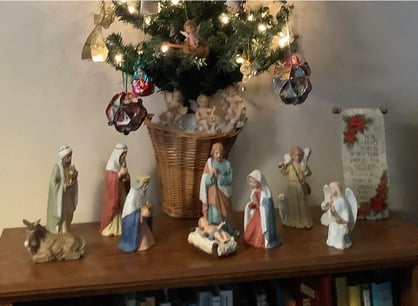
We recently been seeing the removal and even destruction of statues of certain famous people who, besides their heroic deeds, had either committed or permitted some not-so-admirable practices.
This underscores for me the fact that we humans like visual aids to reinforce certain ideals or to perpetuate certain virtues. Eyes-on and even hands-on experiences are effective for teaching and making lasting impressions on us. We find it helpful to see tangible things and not just rely on understanding abstract concepts. We need to “flesh things out.”
While I understand and appreciate Jesus’ birth, there are no photos of his coming. However, I have a lovely set of nativity figurines I put on display every Advent and Christmas season. Right after Thanksgiving, I brought out my set and carefully arranged the porcelain figures on the top of a small bookcase in my living room. I know some people don’t put out the baby Jesus until Christmas Day, but I love that baby all season long, and I know he came, so I don’t wait.
I finished my decorating and went to bed. In the middle of the night, I heard the telltale sound of porcelain clinking together, and then bang! My husband went downstairs and found the donkey from my nativity set broken on the floor. Buddy, our senior cat, had jumped up onto the bookcase and could not get out of his own way. He took off in a guilty flurry and zipped up and down the staircase a couple of times at top speed.
I don’t think Buddy had any dissatisfaction with the donkey. Curiosity was most likely his motivation. Fortunately, it was a clean break and the donkey has already been glued back together and returned to his place in the display. A six-foot long pine board resting against the side of the bookcase at night dissuades the feline climber from future athletic feats.
And now I put forth this question: have you ever prayed with a Nativity set? Certainly, we don’t use statues as idols or gods, but these visual aids can inspire and help us to focus our prayer.
With the Mary figure, we might unite ourselves with the new mother, beaming with joy as she looks at the sweet infant in the manger. We can smell the hay in the manger and say a prayer of thanksgiving for generous Mary who agreed to be the Mother of God.
With the Joseph figure, we might say a thank-you prayer to him who modeled for us obedience and faith in God’s will. We might ask the Lord for strength like Joseph had.
The animal figures and the humble setting of a stable can make the story even more real for us. The animals’ breath could be warming the chill in the air.
The baby in the manger represents Jesus. His simple beginnings can teach us that our prayers can be simple, little prayers that grow as we grow closer and closer to him. We can pray a thanksgiving prayer to Jesus for experiencing human babyhood and for loving us all our lives, from infancy to old age.
If the three kings are in the scene, we can again pray to be like them, giving gifts, especially ourselves in love, to the Son of God.
Glory to God in the highest heaven,
and on earth peace among those whom he favors. (Luke 2:14)
†††
Sharon Krause photo
The scripture verse is from the New Revised Standard Version Bible: Catholic Edition, copyright © 1989, 1993 the Division of Christian Education of the National Council of the Churches of Christ in the United States of America. Used by permission. All rights reserved.
Sharon Krause is a RENEW volunteer whose writing has appeared in several resources for small-group faith sharing. She is a wife, mother, and grandmother residing in Manchester, Connecticut. Over the years, she has served in many parish ministries.
